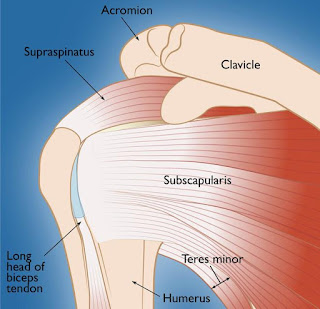BEST EXERCISES FOR TENNIS PLAYERS FOR INJURY PREVENTION AND STRENGTH
An often overlooked part of tennis are accessory exercises off the court. While the best players in the world spend countless hours on the court, many also dedicate time in the weight room as well! This helps them to prevent many common injuries, increase power, and boost explosiveness.
ROTATOR CUFF EXERCISES
How many shoulder injuries have you seen tennis players get? Chances are, if you're serving, hitting overheads, and returning topspin shots, you're eventually going to hurt your shoulder. Elevation of the arm combined with internal rotation of the shoulder leads to should impingement issues and grinding of the shoulder girdle. This is why rotator cuff work is crucial to healthy shoulders. The rotator cuff, located near your scapula, are a set of small muscles that help keep your shoulders in their natural position by "holding" them in place when your shoulder is placed into internal rotation.
Doing rotator cuff exercises that put your shoulders into external rotation will help to strengthen the rotator cuff by eliciting a concentric contraction. Rotator cuff work will also make your posture better. Here are some rotator cuff exercises that I would recommend:
Doing rotator cuff exercises that put your shoulders into external rotation will help to strengthen the rotator cuff by eliciting a concentric contraction. Rotator cuff work will also make your posture better. Here are some rotator cuff exercises that I would recommend:
-Band Pull-Aparts
-Face Pulls
-Rear-delt flys
LEG EXERCISES
The second most common injury tennis players seem to get are knee injuries, and it makes sense. Think about all the running and high impact lunging on the concrete surfaces. It takes a serious toll on your knees, especially if you've been playing for years. This is why it's important to do exercises that will help increase the fluid and blood-flow to your joints, while not completely wrecking your knees. Another component is explosiveness. When you hit a shot, the majority of the power should be coming from the rotation of your hips. Doing exercises that increase the explosive power of your hips will drive up your ball speed on the court. Here are some safe exercises that I would recommend that won't wreck your knees or back, and will do wonders for your game:
-Step Ups
-Reverse Lunges (weighted or unweighted)
-Glute/Hamstring Raise
-Reverse Hypers
-Weighted Hip Bucks
CORE EXERCISES
Stability, rotation, and anti-rotation are key to tennis and the functions of the core. Doing exercises that train these functions will overlap into your tennis game, helping you to hit stronger shots and returns. Core work will also reduce the chances of a back injury, as core muscles keep your spine in place. Not only that, but your core is the base for power. You'll see weightlifters who are able to squat enormous amounts of weight, and this is due not only to strong legs but a bulletproof core. A great comparison to your core is a tin can. If it's stable and not dented, it can support a surprising amount of weight. But if there's one slight dent, it's weak and can't support anything. Here are some exercises that will increase your core's strength in those key functions:
-Banded Woodchoppers
-Weighted Planks
-Band Step-Outs
-Threading The Needle
Google these exercises to see how they are performed!
Google these exercises to see how they are performed!








